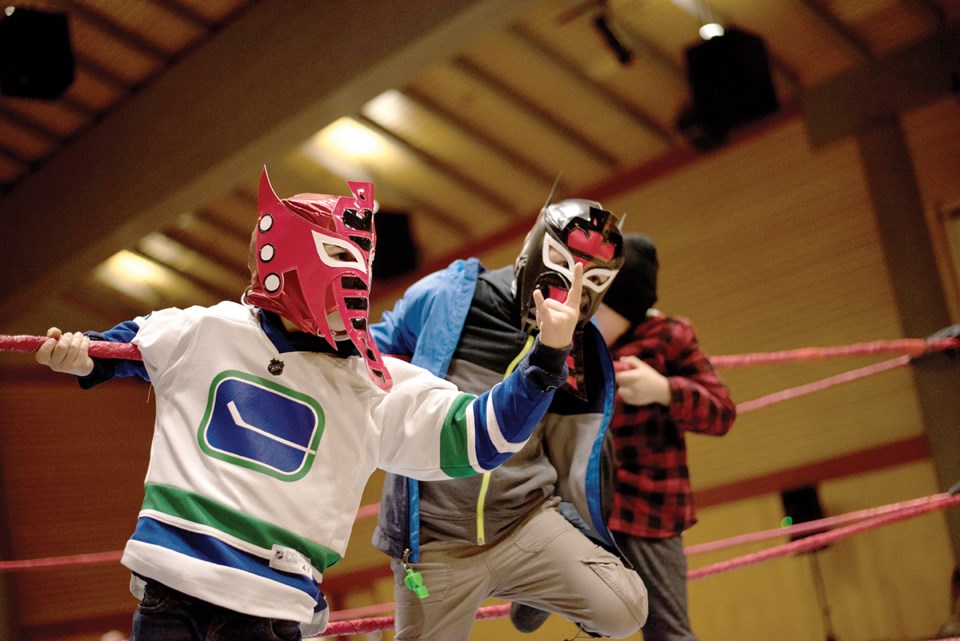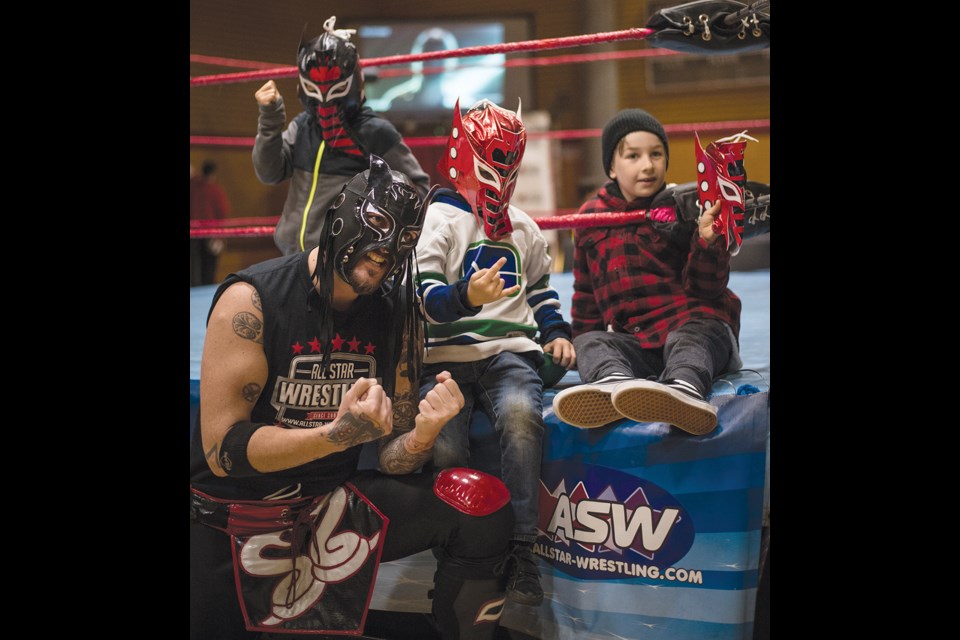You will either love it right through to the afterparty or walk out halfway through.
Whatever your reaction, All Star Wrestling only comes to town twice a year, and you have to see it once.
The kids in luchador masks are adorable. The symphonic music pumping through the speakers suggests a pep rally organized by fans of rock opera. The smell of popcorn and the anticipation in the air is all movie theatre.
But the characters about to emerge from the red curtain are larger than life, and more present than the ones on the silver screen.
Laugher is normal, horrified gasps are normal, booing and jeering are encouraged.
You have to cheer for a hometown hero, but not everyone in the crowd on a Friday night in October agrees, apparently. There are at least a few audience members at the show cheering encouragement as wrestler and reality TV star Judas drops Squamish-born “TKO” through a wooden, folding table, which splinters in half.
The back of his head hits the ground with a thud. Wrestlers sometimes wear masks – but they don’t wear helmets.
In true wrestling fashion, in an interview weeks later, Cody “TKO” Smith doesn’t completely give away whether the big finish was supposed to be that violent.
It looked rough to an unplanned degree, but that is the point of wrestling. It’s part athleticism, part performance art – all intended to make the audience invest in the story.
You can almost hear the shrug in his voice when Smith says, nonchalantly, that wrestling can teach you a lot about what the human body can endure.
“There are lots of aspects I appreciate, lots of life lessons I’ve learned from wrestling,” he says.
Smith watched wrestling growing up, imitating moves with friends in the backyards of Squamish. He was around 18 years old when he first tried out for professional wrestling in Surrey.
“I basically went out for my first tryout and had the whole class line up after the end of practice to shake my hand and hope I come back. I haven’t looked back since. Basically, 13 years later – well – I’m being put through a table at the Totem Hall.”
Besides being put through tables, Smith, or his wrestling alter-ego TKO, has travelled to Japan, Australia and the U.S. He’s been put up in hotels and hosted on talk shows during his part-time professional wrestling career.
He said whether he’s performing for 2,000 people overseas or the 80-strong crowd in Totem Hall, the goal is to put on a good show.
Promoter Mark Vellios, co-owner of All-Star Wrestling, brings the show to Squamish around two times a year because he shares that goal.
“I’m definitely not in it for the money, it doesn’t help my pocketbook,” he admits with a laugh. “But I want to keep local wrestling alive.”
The average Squamish show pulls in about 100 people, says Vellios, with a really good night bringing in around 200 people. The shows are a fundraiser for the Squamish Nation Recreation programs, and sponsors like the Chances Casino help cover the cost of paying the wrestlers.
The shows generally involve one “headliner” star brought in from the U.S or elsewhere, while the rest of the wrestlers come mostly from the Lower Mainland.
The original All Star Wrestling brand began in the 60s and ended in the 80s. Vellios and partner Nathan Burke revived it in 2007, beginning with some fundraiser shows and eventually presenting shows across southern B.C., including Richmond, Chilliwack, Abbotsford, Maple Ridge and Sechelt.
While not every parent is going to feel comfortable with the physicality of the sport (which is sometimes slapstick but sometimes brutal) there are definitely kids at the Totem Hall show using their imaginations.
Five-year-old Phoenix, sitting wide-eyed beside his mom, keeps nervously switching between his black mask or his blue mask in between cheering and booing for the athletes.
Vellios said in the early 2000s, more brutal “hardcore” wrestling was popular, with more blood and more violence. He wanted to keep All-Star Wrestling a family show, focused more on spectacle and less on gore.
“I wanted to get away from that and go back to a family show,” he said. “The guys are very athletic and can do a lot. You see all ages at the show and nothing gets too crazy.”
To provide that showmanship, wrestling needs larger-than-life characters to tell the story. Vellios and Smith both jokingly refer to it as a “man soap opera.” The simmering feuds and petty insults are purposefully over the top.
Smith’s character, the “The Known One,” is tough. His website features a rhyming biography that details his determination and grit but also includes references to his parents and a friendly reminder to drink in moderation.
Smith says TKO represents the everyman, stepping up the challenge and overcoming obstacles. Each person is an individual who can rise to greatness.
“[The idea is] that one person can make a difference, one person can change the world. To be a person who can step up and do something different,” he said.
Smith said in his first professional wrestling match, he was struck by an intimidating six-foot character called Leatherface, who came out “in a Texas Chainsaw massacre Jason mask kind of thing” and proceeded to terrorize the ring.
Just 45 minutes after watching the man go through a flaming table, Smith was introduced to Rick at the after party – and it turned out he was a huggy vegetarian whose kitten had recently passed away.
Some of the characters on Friday night’s roster are less lovable than TKO, and some are just absurd.
Villain Azeem The Dream badmouths Canadians in glittery blue spandex with the U.S. flag draped over his shoulders.
Azeem’s Friday night opponent, Thunder from Jalandhar, comes out from the curtain to blaring Bhangra music. His Facebook page warns he will “Sikh and destroy.” His name is printed on his tight black briefs.
The Funkyard Dogs tag-team, Moondog Manson and Joey Funk, bark and growl like rabid dogs in the ring. The Great Kasaki, half of villainous Tokyo Raiders, has a six-pack drawn onto his stomach with a black marker.
Wrestlers Liiza Hall and Calamity Kate look like badass superheroes in colourful spandex outfits.
The winners of matches are predetermined, but unpredictable. The babyface – wrestling parlance for the good guy – doesn’t always win. It’s all part of the fun, says Smith.
“You’re going to realize really quickly that there’s nothing fake about it, other than the predetermined ending. The good guy can’t just win his match, he has to overcome odds. There’s a storytelling aspect to wrestling,” he said.
“If you want to watch the good guy come back and triumph over evil, you have to stay tuned... come to the show next time they’re in. Hopefully, the hometown hero will pull off the victory, if not, he’ll try again next time.”





